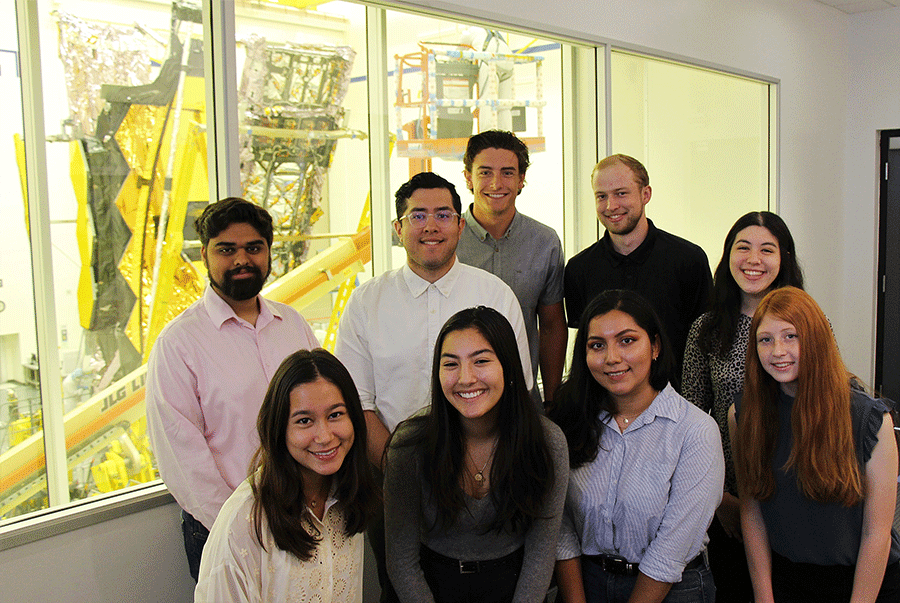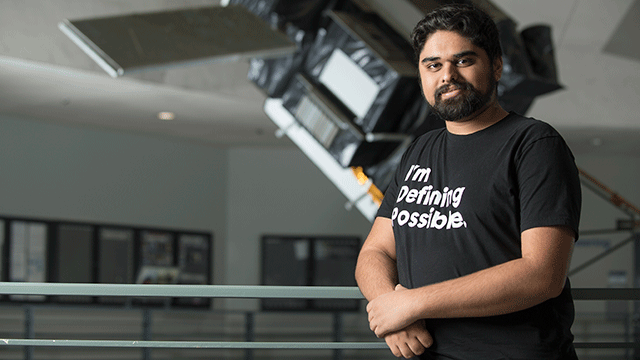On Dec. 22, the most ambitious science project in NASA history - the James Webb Space Telescope - is scheduled to launch, and aerospace engineering senior Jainav "Jai" Gohel has served on its massive team.
Gohel began interning at Northrop Grumman in 2019 and joined its Webb team in 2020. He has already accepted an offer to continue as an operations engineer after graduation in May 2022.
At 22, he's poised to reach a milestone that some space industry veterans spend entire careers only hoping to experience. NASA began developing Webb before Gohel's birth in 1999. To describe this precipice of discovery, Gohel had to grasp for words.
"In general, Webb is a massive object, but when you understand the science it is going to pursue, it becomes truly a technological marvel," he said. "And then you learn how it's going to do that, and you get infatuated by that as well."
Gohel's work included performing and analyzing critical telemetry tests. (Telemetry is the collection and storage of data that is being produced far away, and NASA expects telemetry to begin less than 3.5 minutes after Webb launches.)
The Webb ground operations team praised his curiosity, collaboration and drive.
"Webb will look back at the beginning of the universe and change textbooks that we are studying today," his Northrop Grumman supervisors Robby A. Swoish and Brandon M. Friedlander said in a joint statement. Cal Poly Pomona "should be proud that a member of their community has been able to contribute to this international endeavor benefiting all of humanity."
Pipeline of space engineers
Cal Poly Pomona has possibly the largest aerospace engineering department in CSU system, and its close proximity to the space industry in Southern California is no coincidence. Aerospace majors encounter a learn-by-doing, hands-on engineering approach to education that simulates the aerospace industry culture at companies like Northrop Grumman, SpaceX and others.
"We have a good connection with the industry," said Cal Poly Pomona Astronautics Lab Director Navid Nakhjiri. "They hire graduates from our program, they're happy with them and they come back for more."
Gohel landed the internship as a student at Arizona State, then transferred to Cal Poly Pomona. His transfer coincided with an extraordinary opportunity for any undergraduate: to work on a satellite with the Bronco Space club. Through funding from an anonymous donor, Bronco Space formed, and 35 students worked to prototype and execute tests for a cube satellite (CubeSat) called BroncoSat-1.
"We worked on it basically day and night from the moment we got it in June 2020 till the moment we turned it in in April this year," said Gohel, who grew up in Fremont, California. "The community that we built out of it is the thing that makes me the most happy or proud. Being part of this community is one of my best decisions."
The anticipated launch date for BroncoSat-1 is June 2022.
 Gohel (far left, standing) with his 2020 Northrop Grumman intern class with Webb at Northrop Grumman's facility in Redondo Beach.
Gohel (far left, standing) with his 2020 Northrop Grumman intern class with Webb at Northrop Grumman's facility in Redondo Beach.
The big picture
In high school, Gohel found his specialty within aerospace engineering during an English assignment to interview someone in an interesting job. He visited NASA's Ames Research Center in Mountain View, California, knowing that his attention deficit disorder made big pictures easy for him to grasp; specific details, not so much.
He interviewed a systems engineer, who told him that enormous aerospace projects require exact standards that evolve over long periods of time and much testing. Systems engineers keep track of those standards, and make sure all the teams in the project communicate well. They know they have one chance at success.
"The thing that still appeals about it to me is that you get to be the person who gets to stand back and see the whole thing from the beginning to the end," Gohel said. "You don't design anything or test anything, but every intricate part of the system is under your domain."
On the Bronco Sat-1 project, Gohel served as systems engineering lead for mission operations, inspiring less experienced students like Michael D. Quach, a second-year aerospace engineering student.
"I was a freshman and didn't know where my passion laid," Quach said. "If not for him, I would have been quite lost. I didn't know what a systems engineer did, and now it's something I'm interested in as a career."
Quach now mentors eight students, inspired by Gohel's example.
"He's very positive, and told me to go for it, to not worry if I didn't understand everything, and if I had any questions, to just ask him," Quach said. "You get the feeling that you want to keep going forward even when it's difficult. It's the opposite of imposter syndrome - Jai makes you feel like you belong."
Born leader
Because space projects are bold and high-stakes by nature, aerospace students tend to be very ambitious, said Nakhjiri, an associate professor in the aerospace engineering department. They have to believe they can create new technology, software and other tools to solve unforeseen challenges, while chasing a singular goal.
"Jai's a good example," Nakhjiri said. "He has the vision of where he wants to go, and most of the successful aerospace students have that vision. It's the reason that Bronco Space fully emerged from our students to work on projects like the CubeSat. Ambition is the driving force behind every step they take."
Gohel's inspiration was sparked by a family trip to Mount Shasta's unforgettable canopy of stars and planets. "I had wanted to be an astronaut because that's one of the only careers that exists when you're 5 years old, right?" Gohel recalled. "When I found out that being an astronaut required physical attributes that I don't have, I was like, OK, I'll get as close to the astronaut as I can."
Fremont is smack in Silicon Valley's center, and computer science was often the talk of dinner parties hosted by his father Jayesh (an accountant and business analyst) and mother Charu Gohel (a human resources assistant). "Everyone else was doing computer science and software engineering," said Gohel, who usually joined the adults' table. "I was not going to let myself be one of those people."
In ninth grade, he attempted to join Mission San Jose High School's rocketry program, and when told the national competition teams were full, formed his own. Soon he was leading the rocketry program. It's his habit, Gohel said, to "start like pulling myself into a leadership position, because that is where I function best."
Another training ground was live theater. "A lot of similarities can be drawn with aerospace engineering," said Gohel, who played the lead in his high school's production of Oscar Wilde's "The Importance of Being Earnest" - an upstanding young man who has two identities.
"There's all of the work that goes into what will be hopefully a long-term mission or show," Gohel said. "The energy and magic captured there cannot be replicated in any capacity. You must be there to witness it in that moment, and you must be open to your imagination. And it must go right. And if it doesn't go right, we must keep going."
Back to Webb
James E. Webb led NASA from 1961 to 1968 during the Apollo missions to the moon, which required unprecedented peacetime funding ($24 billion), employed 400,000 Americans at its peak and partnered with over 20,000 industrial firms and universities. The money flowed into university science programs for space research, new laboratories and fellowships for graduate students. This laid the groundwork for generations of STEM majors.
During the fall semester at Cal Poly Pomona, Gohel took spacecraft design, rocket propulsion, engineering ethics, wind tunnel lab and program management.
"To be an excellent systems engineer anywhere - but especially at Northrop Grumman - requires a curious mind," Swoish and Friedlander said. "An engineer who is always seeking to learn more develops a greater understanding of their own system as well as any other systems theirs interacts with. This depth of knowledge is invaluable and only grows with more experience."
When Webb launches, Gohel is curious to see what unfolds along with the golden mirror. Webb's destination is about 1 million miles from earth, beyond servicing by any manned vehicle scheduled for the next decade. Webb has one shot to work.
Meanwhile, he prepares for greater responsibility in space operations. "The high-level big picture," he said, "is where I want to be in the long term." The data that Webb finds - and the system that Gohel has helped test - likely will change our idea of higher and bigger, forever.


